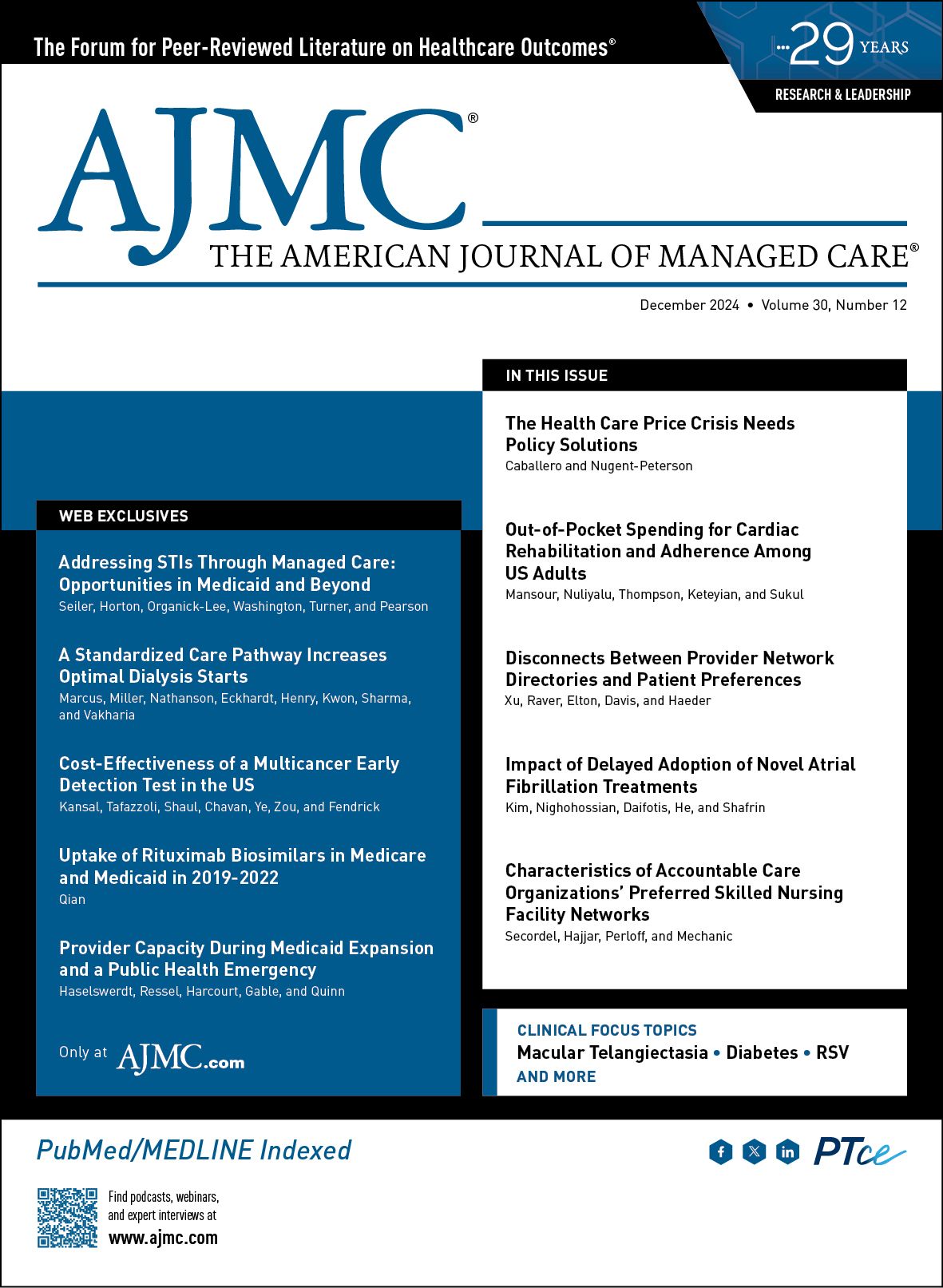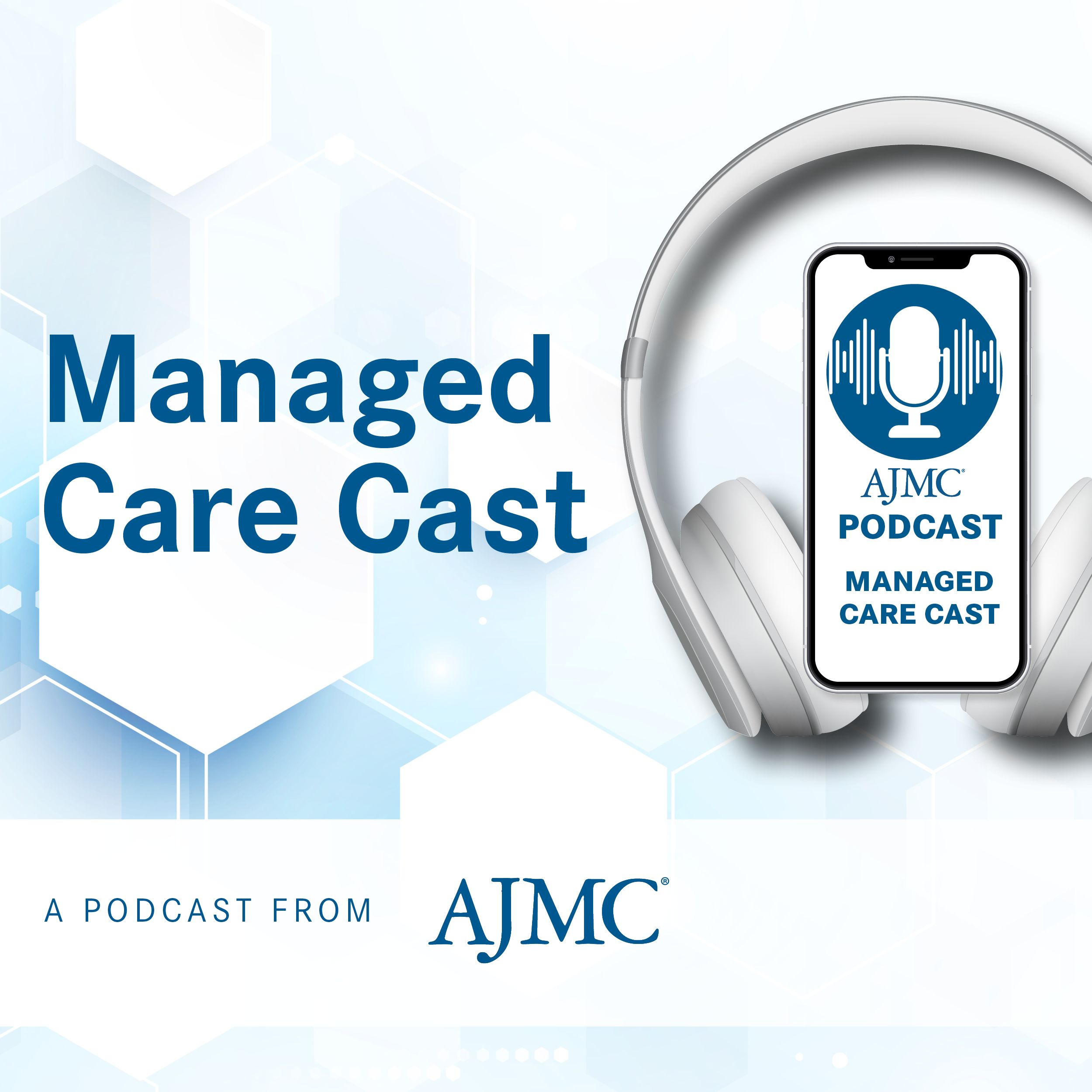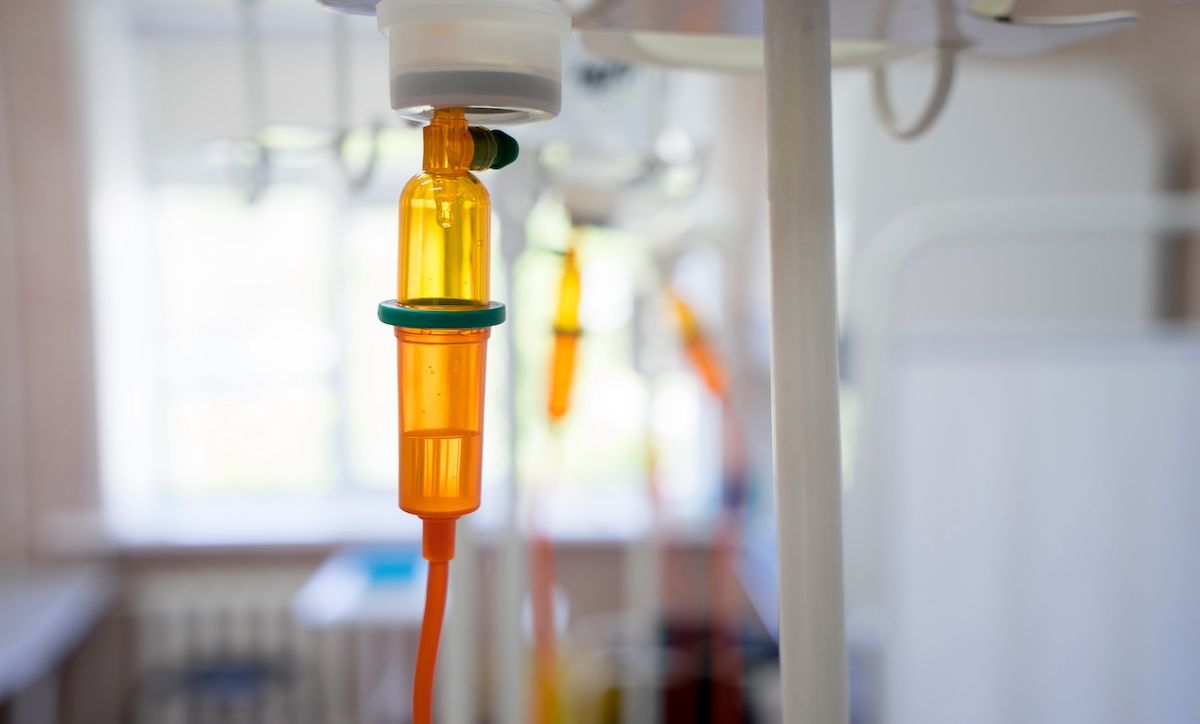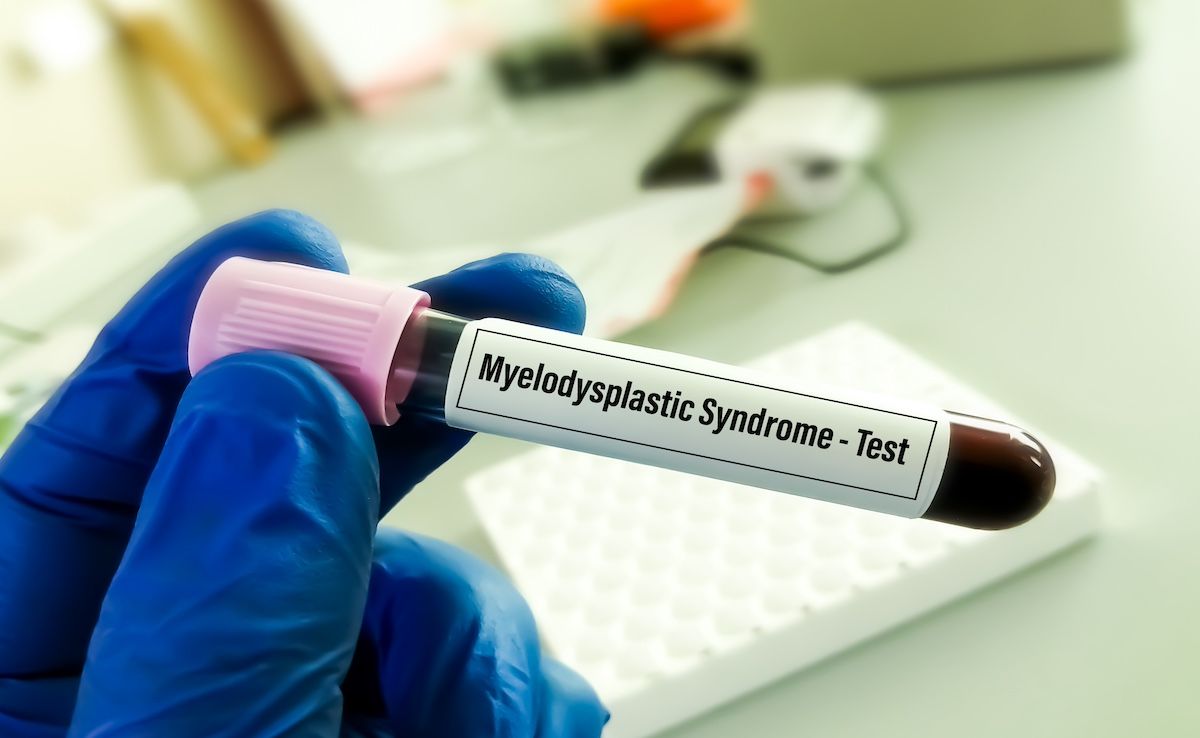Publication
Article
The American Journal of Managed Care
Provider Capacity During Medicaid Expansion and a Public Health Emergency
Author(s):
This survey study finds that most Missouri Medicaid providers had capacity for new patients, even during a period of unprecedented Medicaid enrollment growth.
ABSTRACT
Objectives: To assess the capacity of Medicaid providers to take on new patients during a time of unprecedented growth in program enrollment due to Medicaid expansion and the COVID-19 public health emergency.
Study Design: We conducted a survey of Medicaid providers in Missouri in 2023 about their patient load and capacity to accept new patients.
Methods: We recruited 141 Missouri Medicaid providers through probability sampling and 109 additional providers through convenience sampling for a total sample size of 250, representing 0.8% of all Medicaid providers in Missouri. Our survey was informed by semistructured interviews with 15 providers conducted earlier in the year. We analyzed results using sample percentages with 95% CIs.
Results: As expected, a large majority of respondents reported that their patient load had increased since 2021. Nonetheless, 53% (47%-59%) reported that they personally had the capacity to take on additional patients, and 70% (65%-75%) reported that their larger practice had the capacity to do so. We found no evidence that these responses differed between large metropolitan areas and other areas of the state. Majorities also reported that their practices either had recently hired additional personnel (both staff and providers) or planned to do so, and substantial percentages reported other capacity-expanding changes.
Conclusions: Our results suggest that the health care system in Missouri can accommodate even historic growth in Medicaid enrollment and patient loads without compromising access to care as perceived by providers. Further research is needed from the patient side and focused on rural areas.
Am J Manag Care. 2024;30(12):e364-e369. https://doi.org/10.37765/ajmc.2024.89645
Takeaway Points
We surveyed Missouri providers who serve Medicaid patients to evaluate their capacity to take on new patients in the context of historic enrollment growth in the program.
- These providers reported that increased Medicaid enrollment does not lead to a perceived lack of access for patients.
- Missouri’s health care system can accommodate growth in Medicaid enrollment and patient loads without compromising access to care.
- Medicaid stakeholders and policy makers should consider Medicaid provider capacity and patient access to care in future studies, especially in rural areas.
In 2020, Missouri voters passed a constitutional amendment to expand the state’s Medicaid program (also known as MO HealthNet) to cover the nondisabled adult population (aged 18-64 years) with incomes up to 138% of the federal poverty line (FPL) as incentivized by the federal Affordable Care Act (ACA). This marked a major change in state health policy, as Missouri’s previous income limits for nondisabled adults were only 21% FPL for parents and 0% FPL (ie, no eligibility) for nonparents. As of June 2023, there were 351,849 Missouri Medicaid enrollees in the expansion population,1 representing 23% of 1.5 million total enrollees,2 with a greater proportion of new enrollees likely to come from health care workforce shortage areas.3,4 Notably, expansion began in Missouri alongside another major Medicaid policy event: the “continuous enrollment” provision under the COVID-19 public health emergency (PHE). By preventing current Medicaid enrollees from losing eligibility during the PHE, continuous enrollment led to substantial growth in Medicaid enrollment in addition to that related to Medicaid expansion.5
Since the enactment of the ACA, there have been concerns about whether expanded coverage will stress health care systems and exacerbate existing workforce shortages.3,6 The link between Medicaid expansion and an increase in Medicaid patients and appointments, as well as overall patient loads, is now well established.7-9 Patients who recently gained access to care through expansion may also have more complicated medical needs due to years of inability to access care, potentially placing further stress on health care systems and providers.7,10-12
Research from other states has shown mixed results related to expansion and provider capacity. Several “secret shopper”–style studies found additional Medicaid appointment availability and stable wait times,13-15 whereas another found more limited new appointment availability post expansion.16 Goold and colleagues12 conducted interviews and surveys with providers, few of whom reported that appointment availability and wait times had worsened for established patients. An analysis of national survey data echoed these results, finding that expansion did not reduce access to care for low-income parents who were already eligible for Medicaid prior to the passage of the ACA.17 Alternatively, qualitative interviews with federally qualified health center administrators in 3 states showed that they reported capacity issues post expansion, with limited ability to take on new patients due to workforce shortages.11 For studies that showed positive capacity results post expansion, the authors attributed this to a greater reliance on nonphysician providers such as nurse practitioners, practice changes such as hiring more staff and expanding hours, or potential existing capacity within the health care system.7,12,14,15 Parzuchowski and colleagues18 compared physician office visits in expansion and nonexpansion states and found that expansion did not decrease access or quality of care for Medicaid patients or patients with other coverage types. In contrast, other studies find some evidence that providers accommodated additional Medicaid patients by reducing the number of privately insured patients they treated, although such reductions were typically minor.13,14,19
Provider-side research on Medicaid expansion is less developed than patient-side research focused on new enrollees.19 This study builds on previous provider-side research12,20 on Medicaid expansion through a provider survey informed by interviews. Specifically, we examined the capacity of Missouri Medicaid providers to care for newly enrolled patients post Medicaid expansion. We asked providers about their personal capacity to care for additional patients, the capacity of their practice as a whole, and any steps they have taken to expand their capacity.
METHODS
To assess the capacity of Missouri’s health care system to take on new Medicaid patients, we conducted a mixed-methods study of primary care and specialist providers in the state. We defined a provider as a licensed and board-certified medical provider, which can include primary care physicians, family medicine physicians, nurse practitioners, advanced care nurses, obstetricians, and dentists. First, we conducted a qualitative analysis with 15 interviews of Medicaid providers to explore the perceptions of providers regarding expansion and its impact on their patients and practices. We then used the themes from the interviews to design and deploy a survey of 250 providers to assess the Medicaid provider community’s views of expansion and their ability to take on new patients. These survey results are the primary focus of the present article. The University of Missouri Institutional Review Board reviewed and approved the interview and survey studies.
Qualitative Interviews
A state agency provided initial recruitment geographic and contact information. We restricted our sample to providers who saw at least 10 unique Medicaid patients in 2019, prior to expansion and the COVID-19 PHE. This inclusion criterion is informed by the findings of existing studies that providers with a substantial number of existing Medicaid patients are more likely to accept new Medicaid patients than providers with different patient coverage profiles.17,18 We further limited the frame to rural counties using the Health Resources and Services Administration’s definition of rurality. This was informed by a previous study that identified rural areas as more likely to have a greater proportion of new enrollees.3
Providers were recruited between August and October 2022 via phone calls, emails, faxes, and messages sent in cooperation with state provider organizations. We augmented these recruitment methods with interviewee snowball sampling. Recruitment continued until theoretical saturation was reached. Interviews were semistructured and recorded via Zoom. Two research team members (J.H. and E.H.) were involved in coding themes, and an additional team member (K.R.) served as a reviewer for inconsistencies. Data analysis was performed using NVivo 14 (Lumivero).
Quantitative Survey Development
Based on the resulting themes of this qualitative analysis, we developed a quantitative survey for Medicaid providers. Questions related to the themes that were identified in the qualitative interviews and past Medicaid provider surveys in other states,13 which include providers’ opinions on expansion and access, their thoughts on capacity and workforce either within their own practice or their broader local community, their experience in dealing with the Medicaid program and patients, and their knowledge and information sources regarding Medicaid. The survey instrument was further refined following pilot testing with 6 providers. The present article focuses on the findings related to capacity to accept additional patients.
Quantitative Survey Population
Provider recruitment included a convenience sample and a targeted probability sample from March to June 2023. The convenience sample included referrals from organizations and other providers based on their professional networks. The probability sample included state providers on the American Medical Association physician list through the vendor Medical Marketing Services, Inc (MMS), 7591 of whom met the inclusion criteria and were included in the sampling frame. Recruitment of both samples was limited to providers who saw at least 10 Medicaid patients in Missouri in 2022. In contrast to the interview recruitment, we did not restrict the survey samples by geography. The final sample size was 250 (141 MMS and 109 convenience). The response rate for the MMS probability sample was 1.9%, and the response rate for the convenience sample is indeterminate because the size of the sampling frame that received recruitment messages is unknown.
Data Collection and Analysis of Quantitative Survey
The survey was self-administered via Qualtrics, and consent was incorporated into the survey. Participants were provided a $20 incentive. Demographic questions asked about providers’ gender identity, race/ethnicity, number of years in their profession, provider type, specialty, practice type, and geographic identifiers. The remaining questions had “yes,” “no,” or “I don’t know” answers or standardized Likert scales for agreement, favorability, and frequency. The questionnaire is included in eAppendix A (eAppendices available at ajmc.com). We analyzed survey responses by calculating and graphing percentage estimates with 95% CIs, and data analysis was performed using Stata 18 (StataCorp LLC).
RESULTS
We begin with descriptive information about the 2 samples, benchmarked against data from the 2022 Missouri Medicaid state provider file, displayed in the Table. The provider file data are restricted to providers who treated at least 10 unique patients that year, the same as the inclusion criteria for the sample. As expected, the MMS and convenience samples differed substantially in terms of provider type, with the former made up almost exclusively of physicians, whereas the latter includes dentists and other providers. In terms of specialty, the presence of dentists in the convenience sample again stands out as a noteworthy difference between the 2 samples. The combined sample differs from the provider file on these dimensions in that it overrepresents both physicians and dentists and underrepresents other provider types (notably, nurse practitioners and psychologists). Despite being recruited through a nongeographic probability sampling method, the MMS sample is highly concentrated in the St Louis metro area, particularly the suburban fringe, compared with the convenience sample. Geographically, the combined sample differs from the provider file chiefly in its overrepresentation of large fringe metro areas (again, the St Louis suburbs) and its underrepresentation of large central cities (St Louis and Kansas City) and medium metros (Springfield). Any interpretation of the findings of this study should consider these disparities between the sample and the population of Medicaid providers in the state. Although we report 95% CIs, readers should bear in mind that these ranges are based on random sampling error and do not account for possible bias in sampling. We present results for the full sample in the main text; eAppendix B displays results separately for each subsample.
Before assessing provider capacity, we first established that patient loads have indeed increased for these providers in recent years, whether due to Medicaid expansion, the COVID-19 PHE, or other causes. Figure 1 summarizes providers’ responses to a question about how their patient load has changed since July 2021, when expansion officially began, with 95% CIs. Providers’ experience with patient loads is in line with expectations: Most saw at least “a little” increase in patients per month (the modal response at 43%; 95% CI, 37%-49%), whereas only a small minority (6%; 95% CI, 4%-10%) reported a decrease of any size.
These findings provide important context for responses on the capacity of providers and their practices to accommodate additional patients, which are summarized in Figure 2. Given concern about access in rural areas, we would ideally break out these responses for all geography categories, but we lack the statistical power to do so given the small number of rural (“noncore”) providers in the sample and the population (Table). Instead, we divide the sample between providers in large central or fringe metro areas (St Louis and Kansas City and their suburbs) and all other geographies. The results are modestly encouraging: Approximately half of respondents (53%; 95% CI, 47%-59%) indicated that they personally had the capacity for more patients, and a clear majority indicated that their larger practice had such capacity (70%; 95% CI, 65%-75%). Moreover, the results for large metro and other areas are indistinguishable from one another for both measures. As the results in eAppendix B demonstrate, there were also no significant differences between the MMS and convenience samples for either of these items, despite the very different composition of the samples. The discrepancy between providers’ answers regarding their own capacity and that of their larger practice could reflect objective differences (meaning that our respondents have less excess capacity on average than the system at large) or subjective perceptions of one’s own workload relative to that of others.
Our survey asked providers whether they had completed (since July 2021) or planned to complete any of 4 changes that would allow them to take on more patients: adopting or updating an electronic health record system, hiring more providers, hiring more staff, or making physical changes to their facility. As Figure 3 demonstrates, all 4 changes were relatively common, especially hiring more personnel.
DISCUSSION
The Missouri Medicaid providers in our sample reported an increase in patient load since July 2021, consistent with expectations given the growth in program enrollment due to both Medicaid expansion and continuous coverage policies under the COVID-19 PHE. Even so, approximately half of providers believed that they still had the capacity to take on additional patients, whereas a supermajority believed that their larger practice was able to do so. Importantly, we do not find any evidence that these responses differed for providers outside the state’s large metro areas. These results suggest that increased Medicaid enrollment does not necessarily lead to a perceived lack of access for patients. This is consistent with the findings of other studies concluding that Medicaid expansion does not reduce access,12-15,17,18 although those findings and ours are at odds with the literature on worsening physician shortages nationwide.21 As such, it is important to interpret the findings cautiously.
This apparent extra capacity could be due to existing slack in the system or because providers and their practices have taken steps to expand their capacity. We find that such changes were the norm for practices during this period, with clear majorities reporting that they hired or planned to hire additional providers and staff.This finding could, itself, be evidence of the severity of the provider shortage; perhaps these hires are an effort to address shortfalls rather than grow capacity. Our survey items did specify hiring more providers and staff rather than filling vacancies, although it is possible that some respondents misinterpreted them. Similarly, upgrades and updates to facilities and electronic health records could reflect considerations such as maximizing revenue and updating aging infrastructure rather than expanding capacity.
Our pilot interviews, which were limited to rural areas, also indicated that some providers already had adequate capacity (eg, “I’m still not back to the numbers I was seeing pre–COVID-19”) or that their practices were undertaking changes to meet increased demand (eg, “We are full all the time. We actually have a physician coming in January, which is nice. We’ve been working hard to find somebody.”). Still, it is worth noting that the overall tenor of the interviews with respect to capacity and access for Medicaid patients was negative, particularly among those in rural areas (eg, “When I…started, we had about 4 or 5 providers [in] family practice that I’ve kind of been assimilating their patients in little by little. If we don’t get some of these young residents trained that come from big cities to stay comfortable in rural areas, we’re not going to have providers in rural areas.”). The modestly positive statewide picture suggested by our survey results should not obscure the seriousness of provider shortages in certain areas.
Limitations
A key limitation of our results is the divergence between our total sample and the population of Medicaid providers on the dimensions discussed at the beginning of the Results section. Given the well-documented and increasing difficulty of recruiting health care providers to take part in online surveys22 and the general decline in survey response since the COVID-19 pandemic,23 we do not believe it is possible to recruit a large and truly representative sample of these providers using probability sampling alone. In light of this, we believe the best approach is to be as transparent as possible about our recruiting methods and benchmark the survey sample against available administrative data on the population, as we have done in the Table.
Again, it bears mentioning that truly rural providers make up a small minority of both our sample and the provider population. Although it is encouraging that respondents in and outside large metro areas gave indistinguishable answers in response to the capacity questions, we lacked the statistical power to make meaningful comparisons that isolated the rural noncore category (as distinguished from medium metro, small metro, and micropolitan counties). As such, it is important that readers not interpret our findings as undermining the case for addressing provider shortages in rural areas of the state. Our experience also suggests that future survey researchers interested in rural providers would do well to include specific rural oversampling strategies in their designs to achieve numbers appropriate for quantitative analysis.
Additionally, although the capacity of providers to accept new patients is an important consideration in Medicaid policy, provider surveys like ours are not a substitute for studies of access at the patient level. For provider capacity to translate to access to care, patients must have knowledge of the practice and access to transportation. Moreover, a provider-side analysis cannot address the issue of mismatch between patients’ needs and the availability of specific types of care. Lastly, our provider-side study cannot speak to the quality of care that patients receive.
CONCLUSIONS
With the appropriate caveats, our findings suggest that the health care system in Missouri is able to accommodate growth in Medicaid enrollment and patient loads without compromising access to care, at least at the aggregate level, according to health care providers. Many providers and practices seem to have been operating with some amount of excess capacity in 2023 despite historic growth in Medicaid enrollment over the previous 3 years due to continuous enrollment under the PHE and Medicaid expansion.1 Others may have been able to accommodate this growth because they took steps to expand their capacity through new hires or other measures, which our survey found to be very common. Further research is needed at the patient level and focused on specific geographies (rural areas, urban centers) to assess access problems and provider shortages.
Acknowledgments
The authors would like to thank Tracey Greever-Rice, PhD; Jill Lucht, MA; Jon Stemmle, MA; Karen Edison, MD; and graduate research assistants Aida Bilali Ka, MD, MPH; Adam Thorp, MPA; and Hang Qi, PhD, for their contributions to this project. They also thank their pilot and research participants and all the statewide organizations that aided them in recruitment. This work was conducted with the University of Missouri School of Medicine with support from the Health Resources and Services Administration of HHS, grant No. 6 T99HP33557-03-02.
Author Affiliations: Truman School of Government and Public Affairs (JH, KR), Institute of Public Policy (EH, SG), and School of Medicine (KQ), University of Missouri, Columbia, MO.
Source of Funding: This project is supported by the Health Resources and Services Administration (HRSA) of HHS awarded to the University of Missouri School of Medicine (grant No. 6 T99HP33557-03-02). The contents are those of the author(s) and do not necessarily represent the official views of, nor an endorsement by, HRSA, HHS, or the US government.
Author Disclosures: The authors report no relationship or financial interest with any entity that would pose a conflict of interest with the subject matter of this article.
Authorship Information: Concept and design (JH, KR, SG); acquisition of data (JH, KR, EH, SG, KQ); analysis and interpretation of data (JH, KR, EH); drafting of the manuscript (JH, KR, EH); critical revision of the manuscript for important intellectual content (JH, KR, EH); statistical analysis (JH); obtaining funding (KR, SG, KQ); administrative, technical, or logistic support (KR, SG, KQ); and supervision (JH, KR, SG).
Address Correspondence to: Kristi Ressel, MPH, University of Missouri Truman School of Government and Public Affairs, 615 Locust St, E004 Locust Street Bldg, Columbia, MO 65211. Email: resselk@missouri.edu.
REFERENCES
1. Missouri Medicaid enrollment dashboard. Washington University in St. Louis Institute for Public Health. Accessed November 7, 2024. https://publichealth.wustl.edu/items/missouri-medicaid-enrollment-tracking-dashboard/
2. DSS caseload counter. Missouri Department of Social Services. Updated September 18, 2024. Accessed June 4, 2024. https://dss.mo.gov/mis/clcounter/history.htm
3. Ku L, Jones K, Shin P, Bruen B, Hayes K. The states’ next challenge—securing primary care for expanded Medicaid populations. N Engl J Med. 2011;364(6):493-495. doi:10.1056/NEJMp1011623
4. Siegler A. Missouri Medicaid Basics. Missouri Foundation for Health; 2020. Accessed November 8, 2022. https://mffh.org/wp-content/uploads/2020/11/Missouri-Medicaid-Basics-2020-web.pdf
5. McBride T, Jost E. Initial View of the Medicaid Expansion and Public Health Emergency on Hospital Encounters in Missouri. Center for Advancing Health Services, Policy & Economics Research; 2023. Accessed March 1, 2024. https://bpb-us-w2.wpmucdn.com/sites.wustl.edu/dist/1/2391/files/2023/09/BRIEF-MFH_hospitals-ECM_092523_tdm.pdf
6. Hill I, Wilkinson M, Holahan J. The Launch of the Affordable Care Act in Selected States: The Problem of Provider Capacity. Urban Institute; 2014. Accessed November 19, 2022. https://www.urban.org/sites/default/files/publication/22361/413043-The-Launch-of-the-Affordable-Care-Act-in-Eight-States-The-Problem-of-Provider-Capacity.PDF
7. Wishner JB, Burton RA. How Have Providers Responded to the Increased Demand for Health Care Under the Affordable Care Act? Urban Institute; 2017. Accessed March 1, 2024. https://www.urban.org/sites/default/files/publication/94396/2001576-how-have-providers-responded-to-the-increased-demand-for-health-care-under-the-affordble-care-act_0.pdf
8. Curto V, Bhole M. Impacts of early ACA Medicaid expansions on physician participation. Health Serv Res. 2022;57(4):881-891. doi:10.1111/1475-6773.13925
9. Hamel L, Doty MM, Norton M, et al. Experiences and Attitudes of Primary Care Providers Under the First Year of ACA Coverage Expansion: Findings from the Kaiser Family Foundation/Commonwealth Fund 2015 National Survey of Primary Care Providers. The Commonwealth Fund; 2015. Accessed March 1, 2024. https://www.commonwealthfund.org/sites/default/files/documents/___media_files_publications_issue_brief_2015_jun_1823_kaiser_commonwealth_primary_care_survey_ib.pdf
10. Long SK. Physicians may need more than higher reimbursements to expand Medicaid participation: findings from Washington State. Health Aff (Millwood). 2013;32(9):1560-1567. doi:10.1377/hlthaff.2012.1010
11. Ercia A. The impact of the Affordable Care Act on patient coverage and access to care: perspectives from FQHC administrators in Arizona, California and Texas. BMC Health Serv Res. 2021;21(1):920. doi:10.1186/s12913-021-06961-9
12. Goold SD, Tipirneni R, Kieffer E, et al. Primary care clinicians’ views about the impact of Medicaid expansion in Michigan: a mixed methods study. J Gen Intern Med. 2018;33(8):1307-1316. doi:10.1007/s11606-018-4487-6
13. Tipirneni R, Rhodes KV, Hayward RA, Lichtenstein RL, Reamer EN, Davis MM. Primary care appointment availability for new Medicaid patients increased after Medicaid expansion in Michigan. Health Aff (Millwood). 2015;34(8):1399-1406. doi:10.1377/hlthaff.2014.1425
14. Tipirneni R, Rhodes KV, Hayward RA, et al. Primary care appointment availability and nonphysician providers one year after Medicaid expansion. Am J Manag Care. 2016;22(6):427-431.
15. Rhodes KV, Basseyn S, Friedman AB, Kenney GM, Wissoker D, Polsky D. Access to primary care appointments following 2014 insurance expansions. Ann Fam Med. 2017;15(2):107-112. doi:10.1370/afm.2043
16. Melnikow J, Evans E, Xing G, et al. Primary care access to new patient appointments for California Medicaid enrollees: a simulated patient study. Ann Fam Med. 2020;18(3):210-217. doi:10.1370/afm.2502
17. McMorrow S, Kenney GM. How did the Affordable Care Act Medicaid expansion affect coverage and access to care for low-income parents who were eligible for Medicaid before the law was passed? Inquiry. 2021;58:469580211050213. doi:10.1177/00469580211050213
18. Parzuchowski A, Oronce C, Guo R, Tseng CH, Fendrick AM, Mafi JN. Evaluating the accessibility and value of U.S. ambulatory care among Medicaid expansion states and non-expansion states, 2012-2015. BMC Health Serv Res. 2023;23(1):723. doi:10.1186/s12913-023-09696-x
19. Neprash HT, Zink A, Sheridan B, Hempstead K. The effect of Medicaid expansion on Medicaid participation, payer mix, and labor supply in primary care. J Health Econ. 2021;80:102541. doi:10.1016/j.jhealeco.2021.102541
20. Tipirneni R, Kieffer EC, Ayanian JZ, et al. Factors influencing primary care providers’ decisions to accept new Medicaid patients under Michigan’s Medicaid expansion. Am J Manag Care. 2019;25(3):120-127.
21. Zhang X, Lin D, Pforsich H, Lin VW. Physician workforce in the United States of America: forecasting nationwide shortages. Hum Resour Health. 2020;18(1):8. doi:10.1186/s12960-020-0448-3
22. Cook DA, Wittich CM, Daniels WL, West CP, Harris AM, Beebe TJ. Incentive and reminder strategies to improve response rate for internet-based physician surveys: a randomized experiment. J Med Internet Res. 2016;18(9):e244. doi:10.2196/jmir.6318
23. Krieger N, LeBlanc M, Waterman PD, Reisner SL, Testa C, Chen JT. Decreasing survey response rates in the time of COVID-19: implications for analyses of population health and health inequities. Am J Public Health. 2023;113(6):667-670. doi:10.2105/AJPH.2023.307267

Newsletter
Stay ahead of policy, cost, and value—subscribe to AJMC for expert insights at the intersection of clinical care and health economics.





